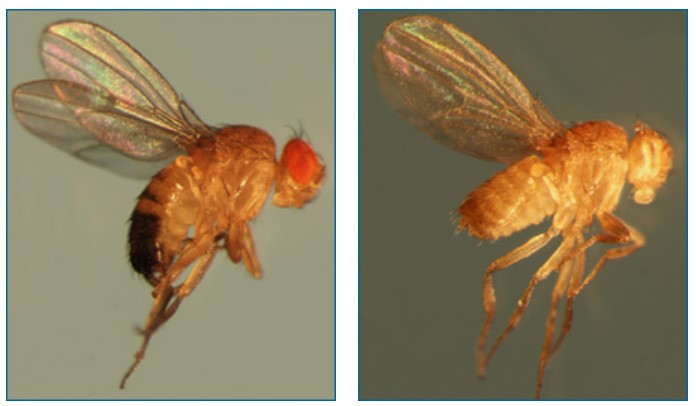In order to figure out what the “mystery” fly gene does, you’ll study the results of three experiments: one looking at what happens when you interrupt the gene with a mutation, one examining where and when the fly gene is turned on, and one in which the gene is turned on in an unexpected place. Specifically you’ll examine the hypothesis that the mystery gene helps control eye development in the fly.
Mutant genes
If this fly gene controls the development of eyes in flies, what would you expect to happen when the gene is disrupted by a mutation that keeps it from doing its usual job? Just as a light won’t turn on if the switch is broken, we’d expect the fly to have trouble developing normal eyes if an eye control gene is broken. When scientists tried this experiment, this is what they found:

Just as predicted! In fact, this particular gene has earned the nickname “eyeless” because of this effect. So far, the eyeless gene behaves just as we’d predict that a control gene for fly eyes would…
All in the timing
If the eyeless gene really does control the development of eyes in flies, where and when would you expect the gene to be turned on? If the gene actually directs the development of eyes, it would have to turn on where the eyes will eventually develop just before eye development begins. Luckily, biologists have developed special labeling systems that let them look into a developing embryo and see where and when a particular gene is turned on. When scientists tried this experiment on developing flies, they found that the eyeless gene is turned on in the places on the head where the fly’s eyes are about to develop. So far, so good…
Franken-Flies
Developmental biologists also study gene function by turning on genes at unusual places or times during the organism’s development. This helps them understand more about how the gene works under normal circumstances. If eyeless really does send out the message “Build an eye here,” what would you expect to happen if you caused the gene to be turned on in the leg of the fly as it develops?
Biologists have done experiments to find out. Again, just as one would expect from a gene that helps control eye development: when it is unnaturally “turned on” in the leg of a fly, the fly develops another eye on its leg!
Putting it all together
What do we conclude from these experiments? Eyeless plays an important role in directing eye development in flies, just as Pax6 is critical for eye development in mice, and just as aniridia is in humans. These bossy genes are powerful — they can turn on all the genes necessary to build a working eye!
